The Toothbrush
As early as 3000 BCE, Babylonians and Egyptians were using twigs with frayed edges to clean their teeth. The first bristle toothbrush identified today appears in 1498 in China when hairs from a boar were fixed to bone or bamboo handles.
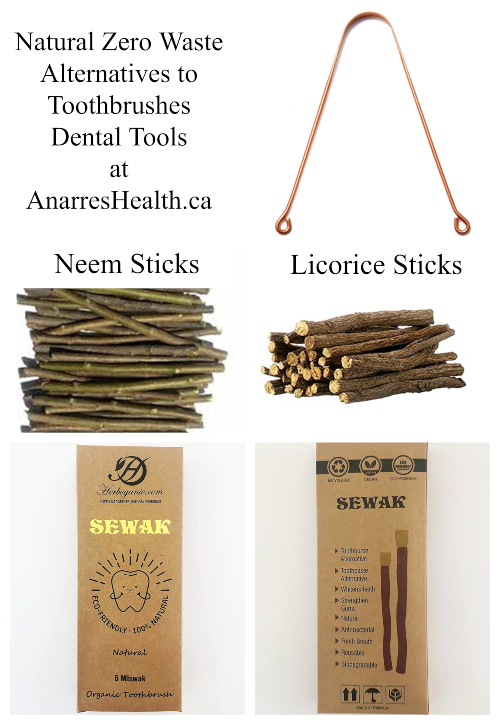
French dentists were the first Europeans to promote the use of toothbrushes in the seventeenth and early eighteenth centuries. William Addis of Clerkenwald, England, created the first mass-produced toothbrush. The first American to patent a toothbrush was H. N. Wadsworth and many American Companies began to mass-produce toothbrushes after 1885. The Pro-phy-lac-tic brush made by the Florence Manufacturing Company of Massachusetts is one example of an early American-made toothbrush. The Florence Manufacturing Company was also the first to sell toothbrushes packaged in boxes. In 1938, DuPont manufactured the first nylon bristle toothbrushes.
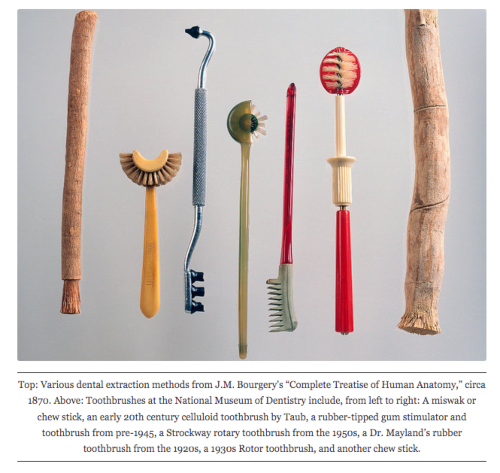
Hard to believe, but most Americans did not brush their teeth until Army soldiers brought their enforced habits of tooth brushing back home after World War II.
The first real electric toothbrush was produced in 1939 and developed in Switzerland. In 1960, Squibb marketed the first American electrical toothbrush in the United States called the Broxodent. General Electric introduced a rechargeable cordless toothbrush in 1961. Introduced in 1987, Interplak was the first rotary action electrical toothbrush for home use.
Toothpaste
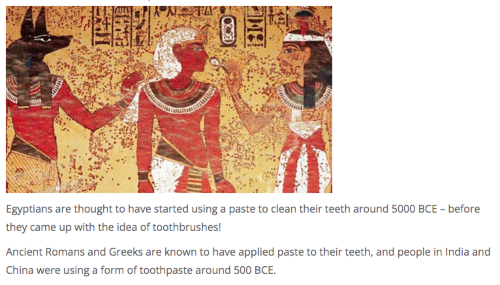
Toothpaste was used as long ago as 500 BC in both China and India; however, modern toothpaste was developed in the 1800s. In 1824, a dentist named Peabody was the first person to add soap to toothpaste. John Harris first added chalk as an ingredient to toothpaste in the 1850s. In 1873, Colgate mass-produced the first toothpaste in a jar. In 1892, Dr. Washington Sheffield of Connecticut manufactured toothpaste into a collapsible tube. Sheffield's toothpaste was called Dr. Sheffield's Creme Dentifrice. In 1896, Colgate Dental Cream was packaged in collapsible tubes imitating Sheffield. Advancements in synthetic detergents made after WW II allowed for the replacement of the soap used in toothpaste with emulsifying (and irritating!) detergents such as Sodium Lauryl Sulphate and Sodium Ricinoleate. A few years later, Colgate started to add fluoride to toothpaste.
Dental Floss
Dental floss is apparently the most ancient dental care invention! Researchers have found dental floss and toothpick grooves in the teeth of prehistoric humans. Levi Spear Parmly (1790-1859), a New Orleans dentist is credited as being the inventor of modern dental floss (or maybe the term re-inventor would be more accurate). Parmly promoted teeth flossing with a piece of silk thread in 1815.
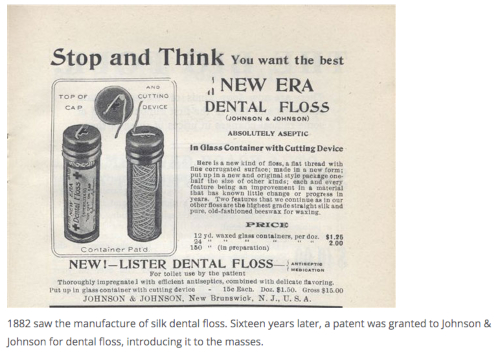
In 1882, the Codman and Shurtleft Company of Randolph, Massachusetts started to mass-produce unwaxed silk floss for commercial home use. The Johnson and Johnson Company of New Brunswick, New Jersey were the first to patent dental floss in 1898. Dr. Charles C. Bass developed nylon floss as a replacement for silk floss during WW II. Dr. Bass was also responsible for making teeth flossing an important part of dental hygiene.
Toothpicks
In 1872, Silas Noble and J. P. Cooley patented the first toothpick-manufacturing machine.

Why use only natural ingredients?
Commonly used oral hygiene products are packaged in plastic, contain ingredients that are irritating to gums and can be toxic when ingested, especially to children. The average North American eats a tube of toothpaste every year. Small children can become seriously ill from ingesting oral hygiene products.
Just because a product is labelled “Eco” or “Green” or has “natural” ingredients, doesn't mean that it's safe. Petroleum by-products are often claimed to be "natural" and can cause cancers. The market is functionally unregulated and makers don't have ingredients tested for safety when used together (in synergy).
PEG is irritating to mouth tissues in concentrations of 2%, but regulations allow a product to be up to 50% PEG! Tests have shown that propylene glycol, for instance, is commonly contaminated with toxins, some of which are banned.
Sodium Laurel/th Sulphate is a detergent associated with canker sores and damage to the DNA of skin cells. Synthetic surfactants release carcinogenic and reproductive toxins such as benzene during their production process, and biodegrade slowly, making them a hazard in the environment. Petroleum distillates have been linked to cancer, lung damage, lung inflammation and damage to mucous membranes.
Artificial flavours, colours and fragrances are made from petroleum (see petroleum distillates above) and do not degrade in the environment. They've been linked to various toxic effects on fish and mammals, and often cause allergies and skin and eye irritation.
And there is nothing eco-friendly about disposable plastic toothbrushes and their packaging!
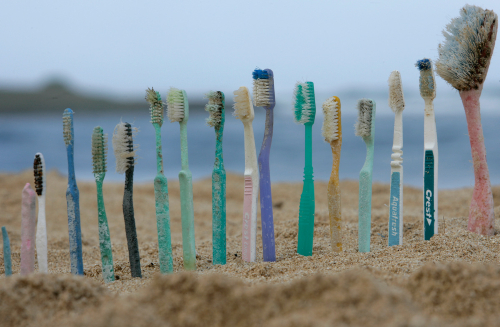
Natural Dental Care Ingredients
Aloe vera Aloe barbadensissoothes and helps heal sensitive gum tissue. Aloe is used in dentistry in a variety of applications: for wound healing, to reduce pain and speed healing of canker sores, and to treat the site of tooth extractions. Beware the preservatives and their percentage used in the gel.
Baking soda Sodium bicarbonate is mild abrasive, deodorizer and an effective and inexpensive fabric softener, scrub cleanser, toilet bowl and oven cleaner, drain opener with vinegar, and water softener.
Bentonite Clay is a mild abrasive to help scrub and polish the teeth. The calcium in bentonite clay may help re-mineralize a tooth with mild decay.
Chamomile Roman Chamaemelum nobile soothes inflamed tissues and nerves.
Lavender essential oil Lavendula angustifolia or officinalis essential oil kills bacteria, viruses, fungus and mould. Safe on skin.
Lemon Citrus limonum whitens, disinfects, boosts human immune system.
Orange and other Citrus oils lift the mood, disinfect, and boost the human immune system.
Peppermint essential oil is a digestive aid. The familiar aroma of Mentha piperita is known for both its warming and cooling properties and is friendly to the sinuses. Prevents and relieves bad breath.
Peroxide Hydrogen peroxide is a disinfectant, oxygen bleach, but can cause stomach problems when ingested.
Salt is a gentle abrasive. Sea Salt allows the body to absorb dozens of essential minerals through the gums including bromides, iodine, magnesium, sodium, calcium and potassium. All these minerals work together as regulators of cell activity and daily functioning, relieving muscular pain and stabilizing fluid levels in the body.
Soap mixes with water, then fats oils and waxes, then water again, rinsing away dirt, grime etc. Liquid soaps are NOT detergents and should be made from Fair Trade Organically Grown vegetable oils. Stephenson's and Dr. Bronner's produce real plain soaps.
Stevia Stevia Rebaudiana is a plant that tastes sweet, is anti-bacterial and does not cause cavities. It helps in improving dental health, treating bleeding gums and other teeth problems.
Strawberries Fragaria vesca rubbed on the teeth fresh are a great low acid whitening agent.
Tea Tree Melaleuca alternifolia essential oil kills bacteria, viruses, fungus and mold. Opens airways, safe on skin.
Thyme, oregano, cinnamon Thymus, Origanum and Cinnamomum essential oils are strong anti-septics but will irritate mucous membranes.
Vegetable Glycerine is used as an agent in toothpaste and many cosmetics. Because it is soluble in both water and alcohol, it is very versatile. It can soften and soothe the skin, and it assists the outer epidermis to retain moisture. Beware "Glycerin" without the "vegetable" qualifier - it's probably a petroleum by-product!
Vinegar acetic acid +-5% stain remover, disinfectant, deodorizer, needs to be watered down to whiten teeth. Look out for all-vegetable vinegar as regular distilled white vinegar is a petroleum by-product.
Witch hazel, the tincture of Hamamelis virginiana is used in dental practice as a sedative or anodyne application, to heal infection and mucous membranes, mouth wounds and to reduce pain and increase healing time.
Xylitol Xylitylglucoside is a sweetener with cavity-fighting properties made from plants such as corn and birch trees! Its effectiveness can be compared to that of fluoride but without the potentially harmful effects of swallowing fluoride. Xylitol can however irritate the digestive system of people with Irritable Bowel Syndrome and other digestive vulnerabilities, but not likely in the quantities ingested during tooth brushing.
I am continuing to add zero waste, and more natural alternatives, to our contemporary petroleum-based dental tools and supplies http://www.anarreshealth.ca/catalog/body-head-toe-skin-facial-care?page=14